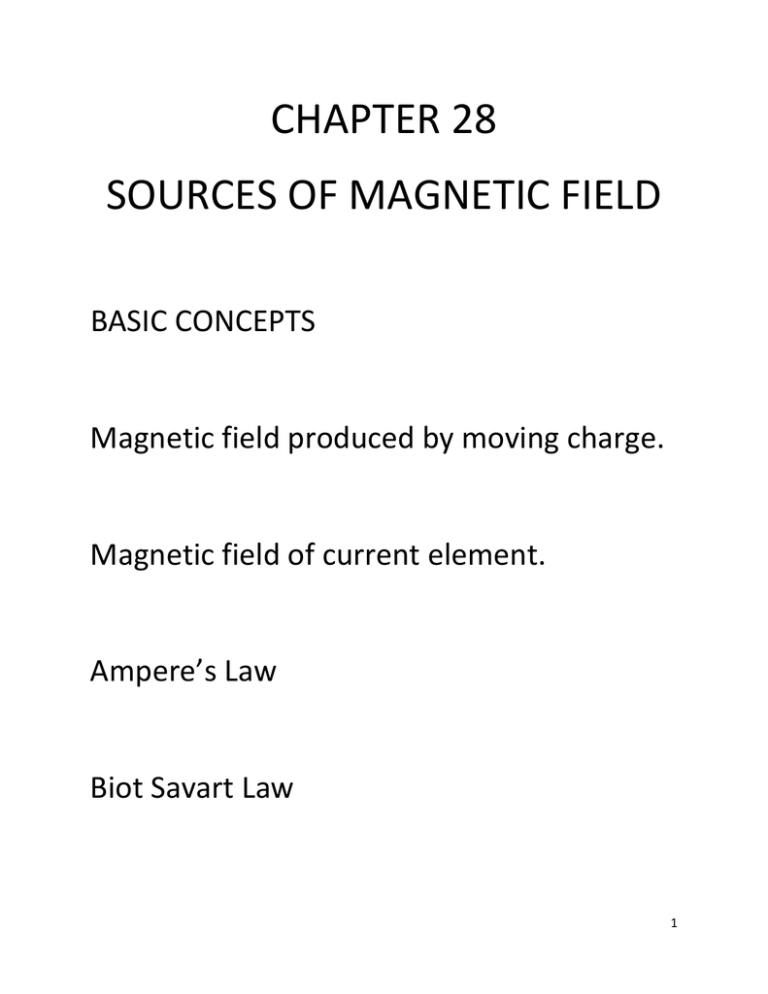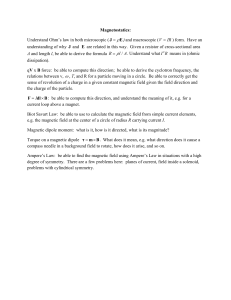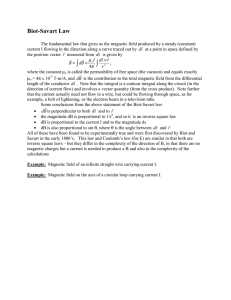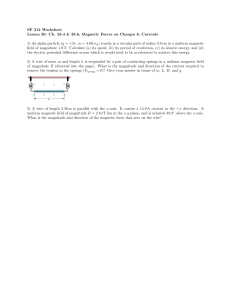CHAPTER 28 SOURCES OF MAGNETIC FIELD
advertisement

CHAPTER 28 SOURCES OF MAGNETIC FIELD BASIC CONCEPTS Magnetic field produced by moving charge. Magnetic field of current element. Ampere’s Law Biot Savart Law 1 Moving Charge A moving charge produces a magnetic field. The field will be perpendicular to the direction of motion of the charge. 2 Magnitude of magnetic field will be Proportional to charge Proportional to Proportional to speed Proportional to 3 Look at figure and note direction of field vector. Field is always perpendicular to the direction of motion and a line from the charge to the point where we measure the field. Therefore is a unit vector. It has magnitude 1. 4 A wire carrying current has moving charge so a wire will produce a magnetic field. 5 Therefore similar to the argument for a moving charge we have the field for a section of wire carrying current: Again is a unit vector. This equation is the Biot‐Savart Law. It can be used to find the magnetic field of wires in various shapes. 6 BIOT‐SAVART LAW 1. The vector dB is perpendicular both to dl (which is the direction of the current) and to the unit vector r directed from the element to the point P. 2. The magnitude of dB is inversely proportional to r2, where r is the distance from the element to the point P. 3. The magnitude of dB is proportional to the current and to the length dl of the element. 4. The magnitude of dB is proportional to sin , where is the angle between the vectors dl and r. 7 Book Example Find B at P. Biot‐Savart Law 8 Therefore a segment of wire will contribute to the field at P. Using and And We get 9 Integrate over length of wire to get total field. 10 This is for a wire with length equal to . To find the magnetic field near a very long wire let . Divide by : And 11 If the wire is very long compared to the distance from the wire then Or at a distance from the wire we now know the magnetic field a distance from a long wire. 12 Consider the wire shown below with current I into the page. P ds Consider path with radius r passing through the point P. ds is in the direction of . Therefore 13 Integrate around the circle. But we have seen that 14 Therefore Finally Then we generalize to any closed path l. 15 This is Ampere’s Law Can be used to find B if geometry is right. Otherwise have to use Biot‐Savart Law. 16 Find the magnetic field at P. Must use Biot‐Savart Law. Contribution to due to small segment of loop will be 17 The component of B in the y direction will add to zero. The component of B in the x direction will be 18 19 20 Find the Magnetic Field inside (r < R) of a conducting cylinder. r We can use Ampere’s Law because of symmetry. 21 Choose a circular path with radius where . Ampere’s Law Integrate around path. Everyplace on the circular path And everywhere on the path B is the same, a constant. 22 Therefore To find need current density, j. Current enclosed 23 The field inside the cylinder. 24 Find the Magnetic Field inside a solenoid. Here we can use either the Biot‐Savart Law or Ampere’s Law. Ampere’s Law is easier. The solenoid has current I and n coils per meter. 25 If we view the solenoid from the far side a cross‐section will be: We will use Ampere’s Law and integrate around the path from a to b to c to d and back to a. 26 Ampere’s Law If the solenoid is long enough the field outside is about zero. The field inside is uniform and pointing to the left (right‐hand rule). The integral then is 27 Or 90 0· 90 So The current enclosed will be the number of coils enclosed time I. 28 Therefore Becomes And 29







